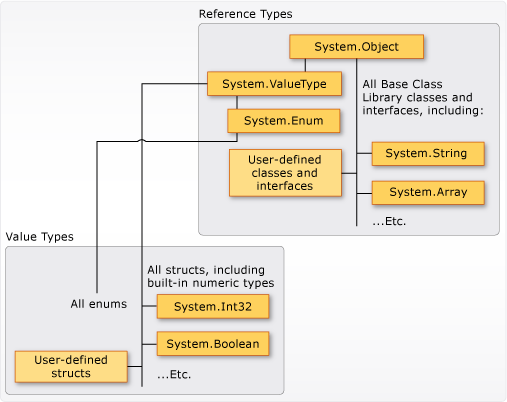一、C# 的数据类型
C# 的数据类型分为 值类型 和 引用类型 。
1.1. 值类型
如:
结构体(struct)
枚举(enum)
数值类型
值类型派生自 System.ValueType (派生自 System.Object )。 值类型变量直接包含其值,没有单独的堆分配或垃圾回收开销。
1.2. 引用类型
如:
类(class)
接口(interface)
委托(delegate)
字符串(string)
数组(Array)
引用类型类似于 C 和 C++ 中的指针的概念。在声明引用类型变量时,它将包含值 null,直到你将其分配给该类型的实例,或者使用 new 运算符创建一个。
二、引用类型的赋值陷阱
2.1. 陷阱
1 2 3 4 5 6 7 8 9 10 11 12 13 14 15 16 17 18 19 20 21 22 23 24 using System;namespace Experiment class TestClass public int a;public int b;public void GetNewValue (TestClass t )new TestClass() { a = 3 , b = 4 };internal class Program static void Main (string [] argsnew TestClass() { a = 1 , b = 2 };
如以上 C# 代码,TestClass 的对象 a 调用 GetNewValue 方法。然而,运行后,对象实例 a 的成员变量的值并未改变为 3,4。
为了方便查看地址的信息,以下用等价的 C++ 代码来实验:
1 2 3 4 5 6 7 8 9 10 11 12 13 14 15 16 17 18 19 20 21 22 23 24 25 26 27 28 29 30 #include <iostream> using namespace std;class TestClass public :int a;int b;void GetNewValue (TestClass* t) "t赋值前:" << t << endl;new TestClass;3 ;4 ;"t赋值后:" << t << endl;void main () new TestClass;1 ;2 ;"a赋值前:" << a << endl;GetNewValue (a);"a赋值后:" << a << endl;
运行后的结果是:
1 2 3 4 a赋值前:00AB8FC8
可以看出,形参 t 在 a 传入后,其指向的地址为 a 对象实例所在的地址,然后 t = b 之后,t 指向了 b 对象实例的所在地址,而这个而改变并没有发生在 a 上。
在 C# 中,引用类型变量的赋值实质上也是发生了以上 C++ 代码的过程。
2.2. 解决方法
解决方法有两种思路。
第一种是不给 t 赋值,二是通过 t 直接修改 a 成员变量的值:
第二种是使用 ref 或 out 关键字,这种方法就类似于 C++ 的引用形参
1 2 3 4 5 6 7 8 9 10 11 void GetNewValue (ref TestClass tnew TestClass() { a = 3 , b = 4 };void GetNewValue (out TestClass tnew TestClass() { a = 3 , b = 4 };
关于 ref,out 以及 in 的区别
out:设置用作此形参的实参的值,方法内必须给参数赋值。
ref:可修改用作此形参的实参的值。(类似 C++ 的引用形参)
in:不会修改用作此形参的实参的值。(类似 C++ 常引用形参)
详见 编写安全有效的 C# 代码 | Microsoft Docs
